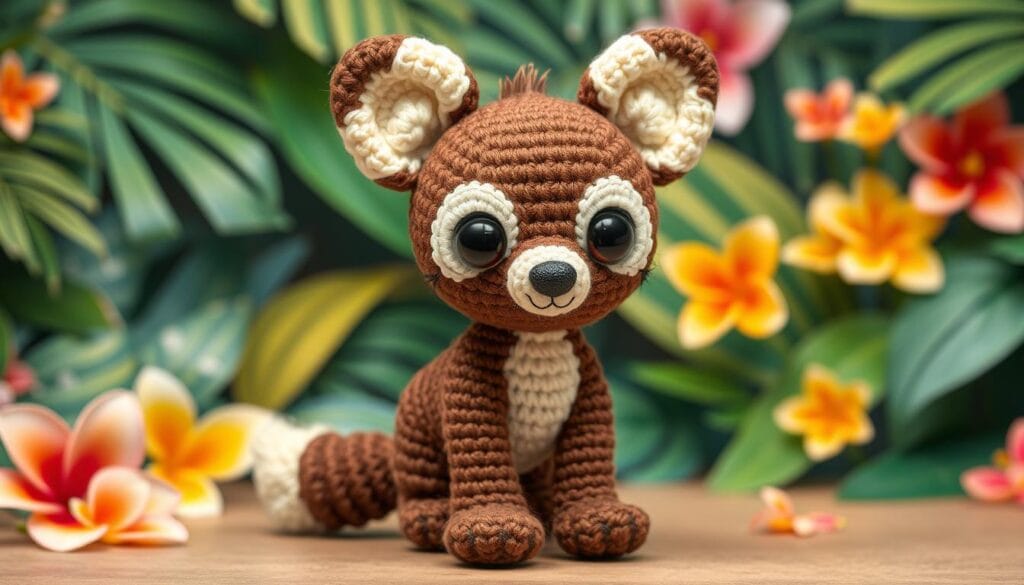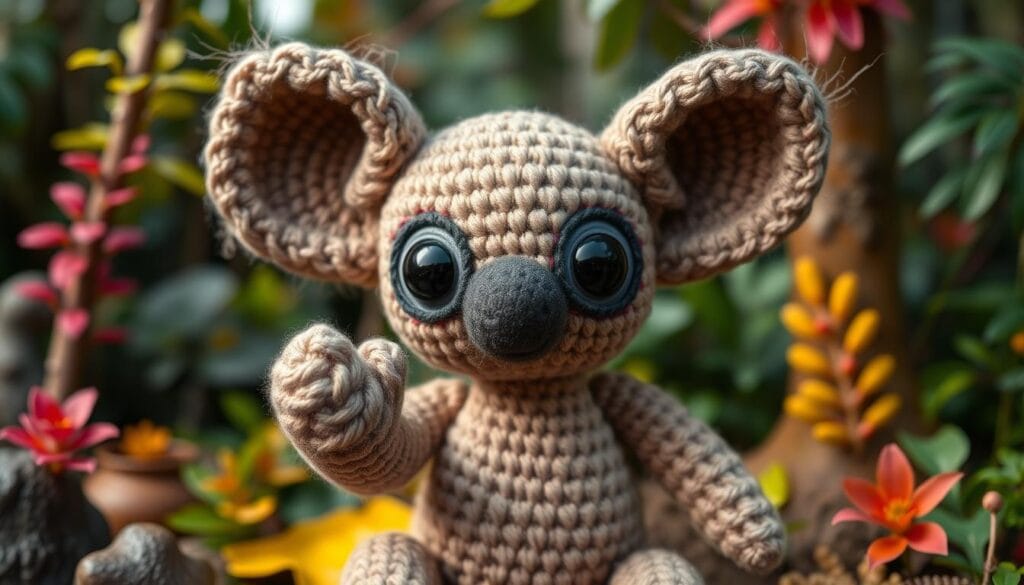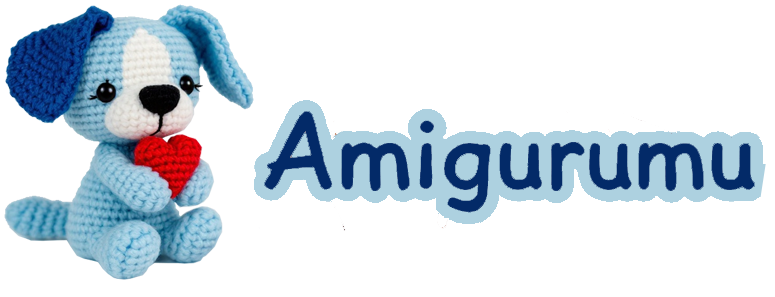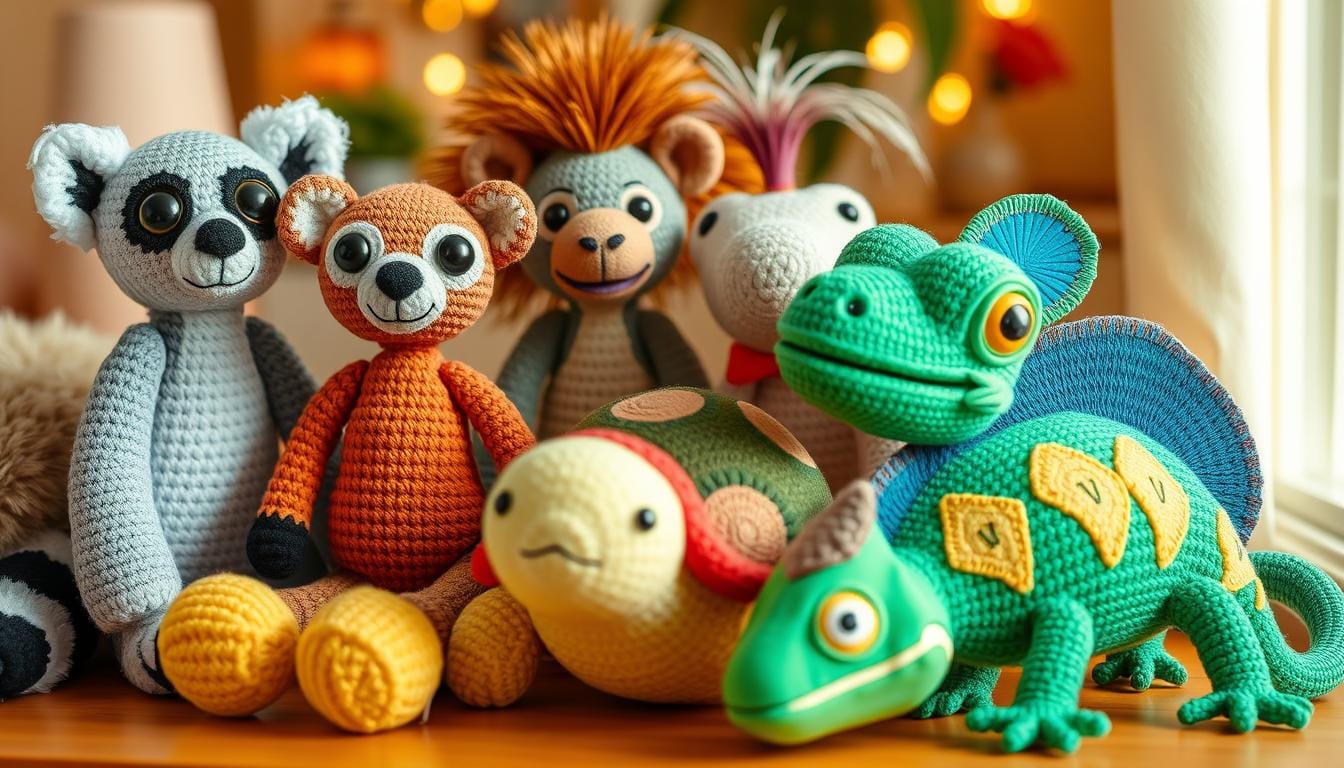Easy Amigurumi Madagascar Animal Crochet Projects
As a parent, I’ve always loved the colorful characters from Madagascar. Crocheting these animals brought me joy. It’s a way to share their wonder with kids.
These easy amigurumi patterns are perfect for anyone who loves to crochet. You can make lovable friends like lemurs and lions. They’re great for play, decor, or gifts.
Table of Contents
Getting Started with Madagascar-Inspired Amigurumi
Start your creative journey by bringing Madagascar’s african wildlife to life with amigurumi crochet. It’s fun for both newbies and experienced crafters. You’ll find all you need to start these charming madagascar fauna projects.
Essential Tools and Materials
You’ll need a crochet hook, yarn, polyester fiberfill, and safety eyes. A smaller hook gives a tighter stitch and better shape.
Basic Crochet Techniques for Beginners
Learning the basics of amigurumi crochet is crucial. Start with the single crochet stitch. Practice increases and decreases to shape your pieces. Many patterns use a continuous round, so you won’t need seams.
Choosing the Right Yarn Types
Choosing the right yarn is key for your amigurumi. Opt for plushie or worsted-weight yarns that are soft and strong. They’re great for making cuddly animal friends. Stay away from yarns that split or are uneven, as they can be hard to work with.
With the right tools, techniques, and yarn, you’re ready to make your own african wildlife and madagascar fauna amigurumi. Let your creativity shine and enjoy the process!
“The joy of amigurumi lies in the endless possibilities for unique and whimsical creations. Embrace the crochet techniques and let your imagination soar!”
Amigurumi Madagascar Animal Patterns and Techniques
Exploring Madagascar’s unique fauna through amigurumi crochet is exciting. You can make lemur, fossa, and tenrec amigurumi. Each pattern is a fun challenge for crocheters.
Mastering the ring-tailed pattern is crucial for lemur amigurumi. These primates need careful attention to detail. This ensures their unique features are shown well.
Crafting the fossa amigurumi requires a focus on body shape. It’s important to make it look sleek and agile.
For tenrec amigurumi, focus on the spiky texture. Try different yarns and techniques to capture their look.
Choosing any Madagascar animal to crochet is rewarding. It improves your skills and lets you appreciate the island’s wildlife.
Madagascar-themed amigurumi patterns are perfect for all crocheters. Explore lemur amigurumi, fossa amigurumi, and tenrec amigurumi. Let your creativity shine as you crochet these amazing creatures.
Creating the Perfect Lemur Amigurumi
Make Madagascar’s King Julian come to life with a cute lemur amigurumi. The ring-tailed pattern is key to getting it right. With some crochet skills and creativity, you’ll make a lemur that’s both adorable and detailed.
Mastering the Ring-Tailed Pattern
The ring-tailed pattern makes your lemur special. Crocheting the striped tail adds a real touch. Watch our video tutorials to get it just right.
Adding Character with Facial Features
Give your lemur a unique look with its face. Big eyes and a pointed nose are essential. Try different crochet methods to find the perfect expression.
Tail Construction Tips
The tail is both a look and a structural part. It needs careful shaping and stuffing.
With the right skills and creativity, you can make a lemur amigurumi that’s full of life. Bring the ring-tailed pattern to life and create a delightful friend for everyone.
Crafting the Playful Fossa Character
Let your creativity shine and make the fossa amigurumi come alive! The fossa is a special predator found only in Madagascar fauna. It has cat-like features and a long, slender tail. Making this fun character needs detail and a playful touch.
Choose a yarn that’s a deep, reddish-brown color to match its striking coat. Focus on the body shape, aiming for sleek and streamlined. Make sure the fossa’s pointed ears stand out to show alertness and curiosity.
- Use increasing and decreasing stitches to get the right body shape.
- Add whiskers and paw pads for a more realistic look.
- Make the long, tapered tail carefully to fit the creature’s size.
Mastering fossa amigurumi lets you create a cute friend and celebrate Madagascar fauna‘s unique animals. Embrace the challenge and watch your fossa amigurumi come to life. It will show the playful and captivating side of this amazing animal.

Madagascar’s Unique Tenrec: A Step-by-Step Guide
Discover the magic of Madagascar with a tenrec amigurumi. This spiky creature is a natural wonder. It’s a fun challenge for crocheters of all levels. Follow this guide to make your own tenrec, learning to create its spiky texture and choosing bright colors.
Building the Spiky Texture
The tenrec’s spiky coat is its most striking feature. Start by crocheting the body in brown and beige yarn. These colors match the tenrec’s natural look.
Use short, stiff stitches to mimic the tenrec’s quills. Try different stitch lengths and densities to get the spiky look right. This will make your tenrec truly unique.
Color Combinations and Details
Make your tenrec come alive with the right colors and details. Stick to earthy tones for the main body. Add light accents to show off its face.
Focus on the tenrec’s pointed snout and big eyes. Make sure these features are accurate in your crochet. Aim for a tenrec that’s about the size of a palm.
Let the tenrec’s spiky texture and look inspire your next project. With practice and these steps, you’ll create a delightful Madagascar creature.
Designing the Mysterious Aye-Aye
Creating an aye-aye amigurumi takes you into the world of Madagascar’s unique primate. This creature is known for its large eyes, long fingers, and bushy tail. It’s a fascinating challenge for crochet lovers.
Use dark yarn colors to capture the aye-aye’s mysterious night life. Make sure to focus on the middle finger, which it uses for tapping and finding food. A slightly larger size will help show off its special features.
Remember the aye-aye’s big ears and teeth when designing. These help it find grubs in tree bark. Add these details to make your amigurumi a true and captivating Madagascar fauna representation.
Whether it’s a solo aye-aye or part of a Madagascar scene, your hard work will impress. Your dedication to detail and authenticity will win over crocheters and fans of the aye-aye amigurumi and madagascar fauna.

Essential Tips for Professional-Looking Finishes
Making stunning amigurumi toys is more than just crocheting. The final touches and details are key to a professional look. Whether you’re making stuffed toys or handmade crafts, these tips will take your amigurumi to the next level.
Secure Stuffing Methods
Getting the stuffing right is vital for your amigurumi’s shape and life. Use high-quality polyester fiberfill for the best results. Make sure the stuffing is spread out evenly to avoid lumps.
Too much stuffing can make your toy misshapen. Too little, and it might lose its shape over time.
Joining Techniques
The way you join your amigurumi parts is important for its look. The whip stitch and invisible seam are great for smooth, professional joins. They hide the seams, making your creation look unified.
Adding Final Details
The last details can really make your amigurumi pop. Embroidering eyes, nose, and mouth adds personality. For bigger toys, use wire for poseable limbs. This lets you change the toy’s pose, adding fun and versatility.
Mastering these tips will help you make amigurumi that wins hearts. Your stuffed toys and handmade crafts will show off your skill and attention to detail. They’ll truly stand out.
Troubleshooting Common Amigurumi Challenges
Crafting amigurumi figures can be fun but also challenging. When you start your Madagascar-inspired crochet projects, you might face common problems. But don’t worry, with the right techniques and a bit of troubleshooting, you can overcome these issues and make beautiful amigurumi pieces.
One big issue is keeping the tension even. If it’s not, you might get gaps or shapes that aren’t right. To fix this, use stitch markers to keep track of your stitches. Also, count them often to make sure they’re even. Doing exercises to control tension can also help you get better at it.
- Utilize stitch markers to maintain consistent stitch count
- Practice tension-control exercises to achieve even stitches
- Refer to video tutorials for visual guidance on tricky techniques
Shaping complex features, like a lemur’s face or a tenrec’s spikes, can also be tough. For these tricky techniques, video tutorials are very helpful. Joining online amigurumi communities can also give you lots of support and advice from other crafters who have faced these challenges.
| Amigurumi Challenge | Percentage of Crafters Affected |
|---|---|
| Consistent Stitch Tension | 85% |
| Understanding Complex Patterns | 60% |
| Neatly Sewing Parts Together | 40% |
| Achieving Proper Stuffing | 75% |
| Executing Correct Color Changes | 55% |
By working on these common challenges with better techniques, visual aids, and community support, you can improve your amigurumi projects. You’ll be able to make Madagascar-inspired crochet masterpieces that will amaze and impress everyone.
“Embrace the challenges, and let them fuel your passion for this unique crochet craft.”
Caring for Your Madagascar Amigurumi Collection
Proper care and storage are key to keeping your handmade stuffed toys and handmade crafts from Madagascar looking great. By following a few simple steps, your stuffed toys will stay vibrant and ready to bring joy for years.
Cleaning Instructions
For minor stains or dirt, spot cleaning is best. Don’t soak the whole toy in water, as it can ruin the stuffing and stitching.
When a deeper clean is needed, hand wash the amigurumi in cool water with a gentle, color-safe detergent.
Storage Solutions
- Keep your Madagascar amigurumi collection in a cool, dry place away from direct sunlight.
- Use clear storage boxes or display cases to protect the toys from dust and accidental damage. This way, you can also admire your collection.
- Avoid squishing the toys, as it can change their shape. Gently place them in the storage containers, keeping them in their original form.
By following these simple care and storage tips, your Madagascar-inspired amigurumi will stay in perfect condition. They’ll be ready to be cherished and shared for years to come.
Conclusion
The world of amigurumi Madagascar animals is both fun and educational. It lets you explore the island’s unique animals through crochet. These projects are great for learning new skills and being creative.
They also make wonderful decorations, friends, or gifts for others.
If you love crochet or want to try it, this guide has lots to offer. You can make everything from cute lemurs to mysterious aye-ayes. Each crochet pattern brings a piece of Madagascar’s wildlife to life.
We invite you to explore this exciting part of crochet. Start your own collection of amigurumi Madagascar animals. Share your creations with everyone and let these animals spark your creativity.

